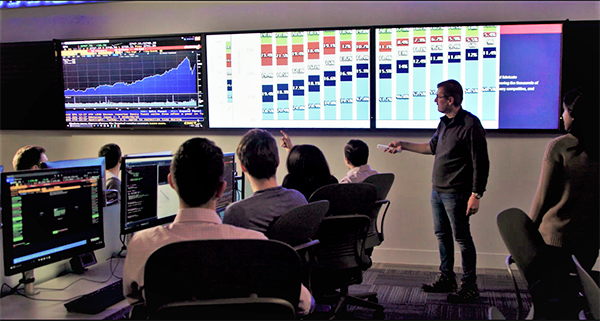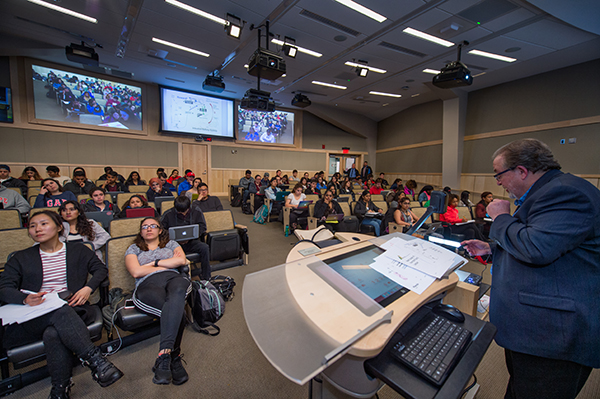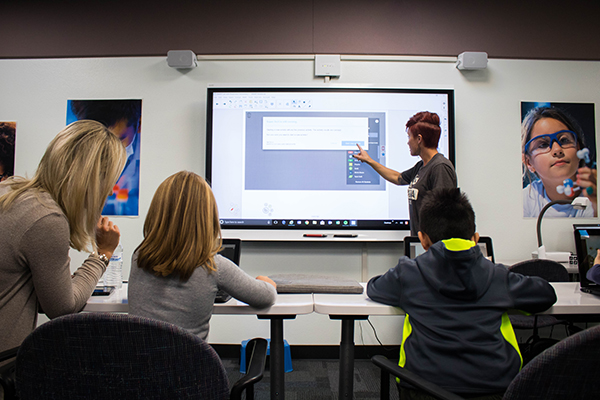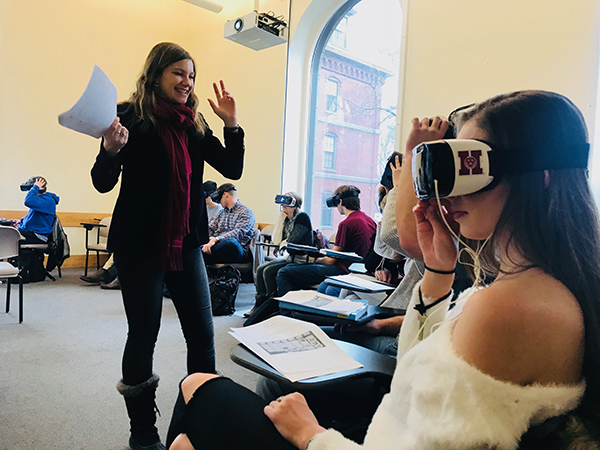Students Help to Lead Technology Adoption in Educational Experience
by Kirsten Nelson
 Students, in many ways, are driving the educational experience now. Not only because they are highly qualified technologists who bring new perspective on which tools best serve the interests they’re cultivating, but also because the pedagogy has been flipping ever so slightly with evolving learning styles and increasing tuition costs. Students are now premium customers for the education experience. And that truth originates early, in K-12, when the preferred technologies of youth determine the success of schools that must pass muster for funding.
Students, in many ways, are driving the educational experience now. Not only because they are highly qualified technologists who bring new perspective on which tools best serve the interests they’re cultivating, but also because the pedagogy has been flipping ever so slightly with evolving learning styles and increasing tuition costs. Students are now premium customers for the education experience. And that truth originates early, in K-12, when the preferred technologies of youth determine the success of schools that must pass muster for funding.
With the arrival of each new class, learning spaces evolve with the cues instructors receive about how pupils want to learn. And as educators continue to explore new ways to engage students, technology supporting the educational experience will continue to evolve.
There to help interpret students’ and educators’ needs are AV and IT technologists, who often collaborate on campus to bring the best experience possible to students. The pace of change is rapid, and what was new last year has become something else as technologies and methods evolve with trends driving change. Here’s a look at how things are combined and defined in 2018.
Distance Learning Meets BYOD
 Distance learning now not only encompasses lessons streamed to far-flung students, it also includes “the extended classroom.” This is a more local kind of distance learning, that includes dorm rooms and other campus facilities where students might access live or on-demand content when circumstances prevent them from attending classes or lectures in person.
Distance learning now not only encompasses lessons streamed to far-flung students, it also includes “the extended classroom.” This is a more local kind of distance learning, that includes dorm rooms and other campus facilities where students might access live or on-demand content when circumstances prevent them from attending classes or lectures in person.
These offerings were helped along in popularity by more efficient audiovisual content transmission methods paired with increasing bandwidth. Streaming and massive content file distribution used to bog down the network, and now it’s much less of a headache, which means the IT department is a little happier with AV collaborators today.
Now, essentially, the classroom is anywhere and everywhere, which requires more audiovisual display and control equipment. “From a needs analysis standpoint, we’re seeing priority placed on the holistic student experience,” said Michael V. DiBella, Vice President of Marketing with IVCi. With students only in the classroom for 18-20 hours per week, he elaborated, design and integration goals emphasize the addition of technology to support learning and socializing throughout their campus experience. “It used to be the student walked in, and learning was bound by what technology was in that classroom. Now the students are walking in with what are essentially videoconferencing and media collaboration devices, and they’re using those anywhere students congregate.”
Across campus, that means providing students with control systems and technologies to connect with displays, access content on school servers and use apps on devices themselves, DiBella said. “The ability to toggle back and forth is becoming such a huge thing.”
To enable use of the growing multitude of these tech-enhanced collaborative and huddle spaces, wireless network support has evolved considerably in recent years. Challenges associated with BYOD still keep campus IT departments busy, but the call for network access from both the student and instructor side has prompted much positive change, observed Mike Morgan, General Manager, Central Pennsylvania for New Era Technology.
“For guest networks, they’ve been tasked with and have done an extremely good job over last year or two to provide infrastructure so students and faculty can come in and share over a network,” Morgan noted. “Networks are the lifeblood of any organization, and in higher education, if something corrupts your network there are a lot of angry people on campus. So you have to be extremely cautious. But with new IT peripherals out there, it’s becoming easier to accommodate.”
Data Infrastructure Meets Analytics
Advancing network infrastructure, and the continual upgrade of legacy campus backbones are facilitating more than connection and sharing of content and applications. New hybrid data centers also use the cloud to capture technology usage trends.
“Usage data has evolved past determining when the bulb in the projector is about to blow,” DiBella observed. “Analytic tools also provide data on what systems in rooms are being used and not used, which will determine future choices from an investment perspective.” And on the flip side of that equation, a lack of use by certain instructors may prompt certain learning institutions to insist on increased adoption, so that the investment is maximized. “Once they’ve made the investment, it’s, ‘We put that system in here for a reason, you have to use it.’”
In-classroom analytics also influence lesson plans in the form of quizzing and polling technologies, which continue to gain ground in schools. “That bidirectional communication, quizzing and polling, where a teacher can pump out a question to kids, get an immediate response back digitally and then put it on the screen, is communicating with students in a way that they’re used to,” DiBella said. In this way, the response of an entire class can be measured, rather than just that of students who raise their hands to give answers. “These are aspects of the digital world that improve the student experience inside the classroom.”
STEM Meets the Maker Movement
 New trends in experiential learning are aided by technology in a literal and virtual sense. In classrooms from K-12 upward through to higher education, technology can simulate experiences and also enhance those had in the real world.
New trends in experiential learning are aided by technology in a literal and virtual sense. In classrooms from K-12 upward through to higher education, technology can simulate experiences and also enhance those had in the real world.
It begins with a shift toward more interactive learning, where whiteboards and projectors are being replaced by interactive flat panels as display sizes increase and prices decrease. This change is occurring in tandem with increased emphasis on STEM curriculum, where new tools including mobile devices, 3D printers and VR/AR equipment assist in engaging students on science, technology, engineering and math topics.
No longer restricted to institutions of higher learning, cutting-edge technologies are getting into classrooms early to support new learning trends. “Everything in K-12 is going to the students leading the way, rather than students just sitting and hearing a lecture,” said Julie Solomon, Chief Marketing Officer with CCS Presentation Systems - Southwest. This means increased hands-on learning, with convenient new classroom carts loaded with VR headsets and a tablet pre-loaded with lesson plans for the teacher, “that allows you to literally roll it into the room and you’re ready to go.”
Solomon described a similarly ready-to-rock STEM cart that provides Google Chromebooks and 3D printers, so educators “build their own lessons and content for students to learn from and then push it out to the printer to make their own 3D models. Everything is about an experience in the classroom.”
Within the upper grades, K-12 students will also be provided with tools for shooting their own 360-degree video content, Solomon noted. “So, the idea is that you start out with students having headsets to view what’s available, and then the older kids are building content for the younger grades.”
Experiential Learning Meets Virtual Reality
 On a higher education level, VR, AR and MR are adding new dimensions to curricula across many departments, not just those typically centered on “new media” technologies.
On a higher education level, VR, AR and MR are adding new dimensions to curricula across many departments, not just those typically centered on “new media” technologies.
At New York University (NYU), a number of innovative and creative uses of VR are expanding access both inside and outside classrooms across a wide range of departments. Adoption of the technology has created new learning opportunities, both for faculty and students, as they create and use content. Whether or not they’ve donned headsets previously, the new offerings are so easy to use and compelling, new ideas and requests for technology are on a rapid upswing.
“We’re at the beginning of this now, and certainly a chief challenge in all of this is helping faculty explore the possibilities,” said Ben Maddox, Chief Instructional Technology Officer and Deputy Chief Information/Global Technology Officer with NYU. In the translation of learning objectives into potential applications for VR, AR or MR, it’s important to keep sight of the tenets of education experience, he elaborated: “First think about the question you’re trying to ask — the engagement you’re looking for with students and content — and then choose the technologies to support that. Then consider the scale. Over time, how do we see the use of these kinds of tools, and how do we support and enable that.”
Through carefully cultivated VR, AR and MR content, the classroom and campus are extended, enhancing student experience. Locally, students benefit from immersive learning and simulation materials in a safe environment on campus. And the opportunities work in reverse, as well. Remote students can connect with classrooms and experiences on a global scale via VR headsets.
“In addition to how VR can enrich the classroom experience, which is very important to consider, there’s also the question of how can it make distance learning more engaging, more human-centric, more socially engaging with others,” observed Arnaud Dressen, CEO of Wonda VR , which provides a VR content creation and distribution platform for some 40 major universities and counting. “Now we are looking at how you can move away from the limitations of video chats or text messaging to embodied class experiences in VR.”
The question from there is how long will students want to spend in the VR environment. Headsets will improve and become more comfortable, but for now, VR is about short, intense learning sessions, Dressen said. “You can imagine, having a ten-minute discussion one-on-one. For students learning a new language, for example, paired with someone who wants to learn your language, VR provides a more engaging experience.”
Engagement, whether aided by technology or not, is the true purpose of the educational experience. That remains the constant in an ever-changing technological landscape.





